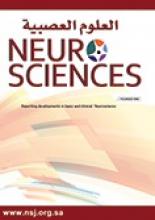Review ArticleReview Article
Open Access
Childhood epilepsies: What should a pediatrician know?
Fahad A. Bashiri
Neurosciences Journal January 2017, 22 (1) 14-19; DOI: https://doi.org/10.17712/nsj.2017.1.20160244
Fahad A. Bashiri
From the Division of Pediatric Neurology, Department of Pediatrics, College of Medicine, King Saud University Medical City, King Saud University, Riyadh, Kingdom of Saudi Arabia
MD
References
- ↵
- Camfield P,
- Camfield C
- ↵
- Kim H,
- Thurman DJ,
- Durgin T,
- Faught E,
- Helmers S
- ↵
- Friedman MJ,
- Sharieff GQ
- ↵
- Foy JM,
- Duncan P,
- Frankowski B,
- Kelleher K,
- Knapp PK,
- Laraque D,
- et al.
- ↵
- Vendrame M,
- Zarowski M,
- Alexopoulos AV,
- Wyllie E,
- Kothare SV,
- Loddenkemper T
- ↵
- Noachtar S,
- Peters AS
- ↵
- Jonsson P,
- Jonsson B,
- Eeg-Olofsson O
- ↵
- Myers CT,
- Mefford HC
- ↵
- Fry AE,
- Rees E,
- Thompson R,
- Mantripragada K,
- Blake P,
- Jones G,
- et al.
- ↵
- Verrotti A,
- Carelli A,
- di Genova L,
- Striano P
- ↵
- Riviello JJ Jr.,
- Ashwal S,
- Hirtz D,
- Glauser T,
- Ballaban-Gil K,
- Kelley K,
- et al.
- ↵
- Warsy AS,
- Al-Jaser MH,
- Albdass A,
- Al-Daihan S,
- Alanazi M
- ↵
- Mohamed S,
- El Melegy EM,
- Talaat I,
- Hosny A,
- Abu-Amero KK
- ↵
- Wilmshurst JM,
- Gaillard WD,
- Vinayan KP,
- Tsuchida TN,
- Plouin P,
- Van Bogaert P,
- et al.
- ↵
- Abend NS,
- Loddenkemper T
- ↵
- Gayatri NA,
- Livingston JH
- ↵
- Mewasingh LD
- ↵
- Graves RC,
- Oehler K,
- Tingle LE
- ↵
- Pavlidou E,
- Panteliadis C
- ↵
- Steering Committee on Quality Improvement and Management, Subcommittee on Febrile Seizures
- ↵
- Kramer U
- ↵
- Adebimpe A,
- Aarabi A,
- Bourel-Ponchel E,
- Mahmoudzadeh M,
- Wallois F
- ↵
- Kwon S,
- Hwang TG,
- Lee J,
- Kim DK,
- Seo HE
- ↵
- Vinayan KP,
- Biji V,
- Thomas SV
- ↵
- Filippini M,
- Boni A,
- Giannotta M,
- Gobbi G
- ↵
- Wirrell E
- ↵
- Glauser TA,
- Cnaan A,
- Shinnar S,
- Hirtz DG,
- Dlugos D,
- Masur D,
- et al.
- ↵
- Lin JJ,
- Siddarth P,
- Riley JD,
- Gurbani SG,
- Ly R,
- Yee VW,
- et al.
In this issue
Childhood epilepsies: What should a pediatrician know?
Fahad A. Bashiri
Neurosciences Journal Jan 2017, 22 (1) 14-19; DOI: 10.17712/nsj.2017.1.20160244
Jump to section
Related Articles
- No related articles found.
Cited By...
- No citing articles found.





